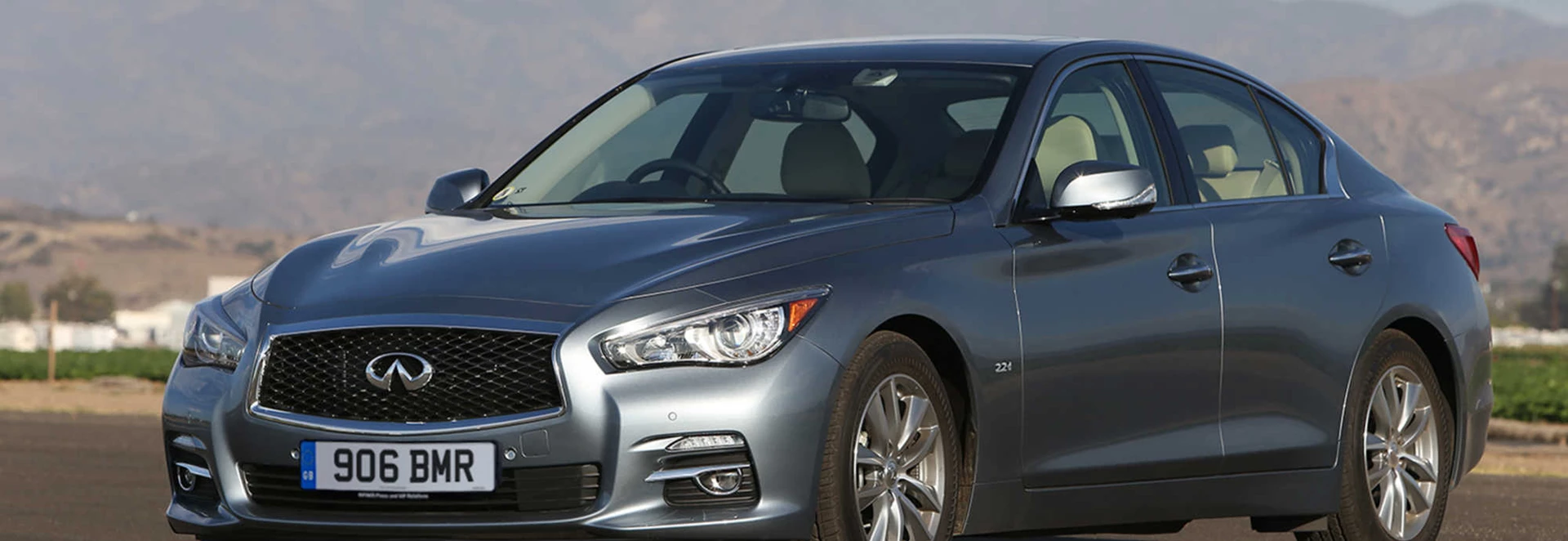The Q50 replaced the G series in 2013 as a rival to other premium sports saloons such as the BMW 3-Series. It's available with a 168bhp 2.2-litre diesel engine, a 208bhp Mercedes 2.0-litre petrol four-cylinder introduced in 2014 and a hybrid powertrain consisting of a 3.5-litre V6 petrol engine and an electric motor.
Seven-speed automatic transmission is almost universal, but the diesel is also available with a six-speed manual. Most versions are rear-wheel drive, though the Hybrid can be specified with a four-wheel drive system.
The most remarkable feature of the Q50 is that there is normally no mechanical connection between the steering wheel and the road wheels. Instead, the relationship is electronic, whose immediate benefit is that it allows for Active Lane Control, whereby the car can stay in its own lane without driver input as long as it can sense clear white lines on either side. The system is also intended to be used to provide autonomous control in future Infiniti cars.
Performance
Infiniti claims to have what it calls a "performance-first ethos", but this is not evident in the Q50. The diesel is decently but not outstandingly quick, with a 0-62mph time of 8.7 seconds and a top speed of 144mph in manual-transmission versions (the figures for the automatic are 8.5 seconds and 143mph). The 2.0T does the 0-62mph run in 7.2 seconds and can reach 152mph.
The Hybrid is limited to 155mph and, in rear-wheel drive form, has a 0-62mph time of 5.1 seconds. The 4x4 might be expected to beat this, but its 76kg weight penalty means that it is actually three tenths slower.
Running in electric mode, the Hybrid is obviously very quiet, but Q50 noise levels are in general quite high. There's a system called Active Noise Control which is meant to counteract this, but it's not particularly effective.
Ride and Handling
he handling can be vague, and you sometimes get the sense that the Q50 is an inch or two either side of where it actually is when you're driving gently.
The unusual steering system has obliged Infiniti to create an artificial "feel". This has been reasonably successful, though it seems not yet to be possible to remove all sense of artificiality. The handling can be vague, and you sometimes get the sense that the Q50 is an inch or two either side of where it actually is when you're driving gently. The handling improves when you start to push on. It's as if the Q50 isn't interested in being a sporty car until it's convinced there is an enthusiastic driver holding the wheel. Ride quality is only moderate, not helped by the 19-inch wheels and low-profile tyres fitted to the Sport version.
Interior and Equipment
The Q50 was the first Infiniti of the modern era to use the Q naming system, which now applies to all models.
Infiniti has done an excellent job with the interior, and in particular with the graphics on the central touchscreen, which are modern without being wacky just for the sake of it. Practicality is limited by the fact that the Q50 is a saloon rather than a hatchback, but its boot is impressively large for the class at 500 litres for the diesel and the 2.0T. The presence of the battery pack in the Hybrid reduces the luggage capacity of that car to 400 litres. There are five trim levels, called SE, Premium, Sport, Premium Tech and Sport Tech. The Tech models are by far the best equipped, as they feature the Visibility, Multimedia and Safety Shield packs. Highlights of these include Around View Monitor, Forward Emergency Braking, Intelligent Cruise Control, a superb 14-speaker Bose audio system, satellite navigation and DAB digital radio.
Cost
You might expect the Hybrid to be the cheapest car to run, but almost exactly the opposite is true.
Oddly, the cheapest models in the range, costing under £30,000, have diesel engines, though that's largely explained by the fact that the 2.0T, which should cost less, isn't available in the SE trim level or with the manual gearbox. Pricing for the Tech models starts at nearly £37k, and the most expensive non-Hybrid is the diesel automatic Sport Tech at just over £39k. Hybrid models, which are sold only in Sport and Sport Tech trim, start at about £40,000 and reach over £46,500 without options. You might expect the Hybrid to be the cheapest car to run, but almost exactly the opposite is true. In rear-wheel drive form it has combined fuel economy of 45.6mpg and CO2 emissions of 144g/km. Of the regular models, only the 2.0T Sport is worse, with 44.8mpg and 146g/km. The four-wheel drive Hybrid has the worst figures of all, at 41.5mpg and 159g/km. The diesel manual's 64.2mpg and 114g/km are far more impressive, though they apply only to SE and Premium models. The Sport's larger wheels bring it down to 62.8mpg and 118g/km, but in both cases Vehicle Excise Duty is a modest £30 annually from year two onwards. The non-Sports are, however, rated one percentage point lower in terms of Benefit In Kind taxation.
Our Verdict
The Q50 is a good-looking saloon with an excellent interior, and its steering technology is fascinating, but while Infiniti continues to present itself as a manufacturer of performance cars we can hardly help criticising it for its limited driving pleasure. This, along with lower public brand awareness of this brand than of Audi, BMW and Mercedes (which Infiniti names as its major targets), is probably not going to help sales, though if you buy an Infiniti nobody could deny that you have made an interesting choice.




